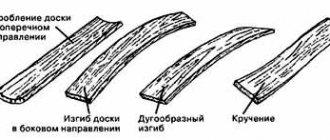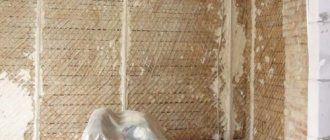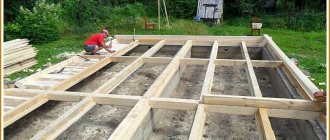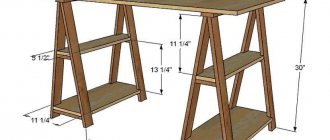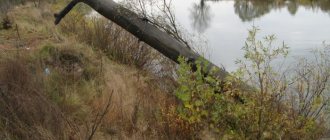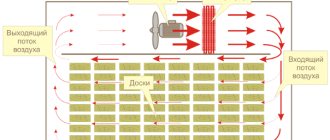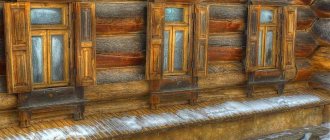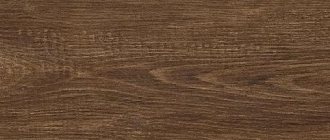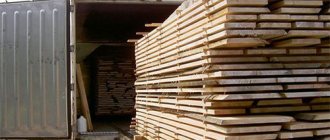Bog oak is one of the most valuable types of wood. It is used for the manufacture of artistic and decorative products. But the extraction and processing of bog oak is a long and expensive process. Therefore, the price of the material is high. Drying stained wood using traditional methods is problematic due to the nature of its structure. We will tell you in more detail how to dry bog oak in compliance with all technologies.
Bog oak is mined on the banks of rivers. Wood can lie in water for more than a hundred years, and then it is taken out and processed. Products made from stained material have a pleasant dark color and are durable. In terms of density, moraine material is compared to iron, so even sawing it is difficult. The humidity of the freshly mined product can reach 117%. Compared to natural humidity of 50–65%, this figure is impressive.
The material is extracted in three ways:
- For bottom-depth work, it is the most costly and painstaking.
- When developing peat bogs, it is less labor-intensive.
- Manufacturing in specialized workshops is the simplest, but multi-stage method.
The weight of wet oak wood is 1500 kg/1 cubic meter. Therefore, immediately after extraction from the water, the material is cleared of silt and sand and cut into small pieces. Otherwise, transportation becomes more difficult.
The tree is afraid of sharp contacts with hot air and direct sunlight, so drying is carried out in a gentle mode. A proven old-fashioned way of drying bog oak is to place small blocks of wood in the grain in the fall and leave until spring. Natural drying is also allowed, but it must be carried out in a room with good ventilation and constant humidity and temperature. It became possible to dry the material in a short time only in the last 10 years, with the advent of new technical means.
The following methods are used to dry bog oak in a short time:
- Vacuum chamber.
- Pulse.
- Adsorption.
- Infrared.
But when dried in chambers, moraine material discolors and becomes less dark. Therefore, many criticize unnatural drying methods. But as it dries naturally, the areas exposed to the sun also become lighter. Chamber drying of bog oak saves time, and if it is carried out in compliance with the technology, then cracks will not appear and the product will not be subject to internal stress.
When chamber drying to different humidity levels, minor changes in geometric shapes are allowed. But if you pre-treat the product with a chemical composition, the changes will decrease. Details are shown in the table below:
| Humidity indicator | Changes in geometric shapes, % | |
| Chemically treated wood | Unprocessed | |
| 50% | 3,5 | 7,2 |
| 25% | 4,8 | 10,7 |
| 15% | 6,3 | 12,6 |
An antiseptic penetrating solution is used as a chemical treatment. The product is soaked in it for 2–3 hours. Drying is also affected by the temperature in the chamber and air humidity. The maximum permissible temperature is 50 degrees - maximum shrinkage. Smaller changes are permissible at a temperature of 25 degrees.
Features of oak wood: what should happen as a result of drying
Oak lumber is quite capricious; it is difficult to dry naturally. It is not enough to simply leave the stack under a canopy or in the open sun to get the desired result after a certain time.
Before drying oak boards
, you need to understand the features of the material:
- Oak wood is susceptible to drying. This means that when the moisture level drops below a critical level, internal and external cracks can form.
- The most difficult thing to dry is freshly sawn oak, whose humidity exceeds 25%.
- Temperatures above 55 degrees are unacceptable during the initial stages of drying. This leads to the collapse of wood capillaries, that is, to the appearance of multiple internal cracks.
- It is not recommended to send freshly sawn material with a humidity above 40% for drying.
- Proper drying of oak requires maintaining a certain level of temperature and humidity.
Features of drying oak wood
are such that in order to obtain high-quality material without defects with a certain percentage of humidity, it is necessary to draw up a preliminary plan for this procedure and use special means. There are several tasks for drying oak:
- Shrinkage with prevention of changes in linear dimensions. Here the humidity is reduced to 30%.
- Drying to transport humidity of 20-22%.
- Full volume drying for immediate use. The humidity level should be 6-12%.
Methods of drying oak: chamber and chamberless methods
From all of the above, it is obvious that obtaining wood from a freshly felled oak that meets all the necessary parameters is a labor-intensive and time-consuming process.
There are many ways to reduce the moisture content of boards, logs and beams, but they can all be divided into two large categories:
- Tubeless (atmospheric) drying.
- Chamber drying.
Atmospheric drying is ideally the most affordable and natural way to reduce moisture levels. The technique has been used in sawmills and wood processing industries for centuries. It is believed that naturally dried wood is of the highest quality and can be used for decades without changing its original qualities. But the method has one significant drawback - it takes a long time.
Since modern life is very dynamic, buyers are interested in purchasing material as quickly as possible. Logging enterprises, in turn, prefer to sell wood as quickly as possible. Therefore, in the 19th-20th centuries, many techniques using electrical energy were invented. Chamber drying is carried out in convective chambers; condensation and vacuum drying are also used.
All work is carried out in industrial conditions, as a rule, divided into the following stages:
- Warm up
- Direct drying.
- Cooling, obtaining a given humidity threshold.
Chamber drying is similar to multi-accelerated atmospheric drying; the desired result is achieved many times faster. But the disadvantage is the high cost of the procedure. It is necessary to use expensive equipment; most often this is only possible in industrial conditions.
Fortunately, not so long ago infrared dryers appeared, which make it possible to reduce the time required for atmospheric drying and obtain the desired result in a time comparable to chamber processing. At the same time, all the features of drying oak wood
, the material does not experience aggressive influences that destroy the structure. At the end of the process, the humidity reaches the required level.
Infrared drying of oak: advantages of the modern method
Proper drying of oak
has now become possible even at home. Infrared dryers manufactured under the FlexiHIT brand have a cassette form factor, are easily located inside stacks, and can also be used for drying small pieces of material. In this case, the volume of wood does not matter; it is enough to use the required number of dryers and position them correctly. The result is achieved in 3-7 days.
The properties of infrared-dried oak correspond to the properties of wood dried by the atmospheric method:
- The material has a specified moisture content.
- The fibers do not warp, cracks and stressed areas do not form.
- The appearance matches that of naturally dried oak.
It is noteworthy that anyone can use IR dryers; you do not need to have special skills to get results. The equipment operates from a regular electrical network and consumes very little. Drying one cubic meter of wood requires no more than 200-400 kW.
To check the humidity, it is enough to use a moisture meter; when the required value is reached, the infrared dryers turn off. The oak can be used for its intended purpose immediately.
Oak wood is quite capricious when dried, so to get the optimal result in the shortest possible time, it is better to prefer tubeless drying in combination with IR dryers.
Bog oak is one of the most precious species and a valuable resource, which is widely used for the manufacture of decorative and artistic products. It has excellent aesthetic characteristics, increased hardness, but also high cost due to the complexity of the drying process. Due to the high density of the structure, it is quite problematic to obtain high-quality stained wood during natural drying. But modern technologies have made it possible to dry wood, taking into account all the characteristics of the material, in a short period of time and with a minimum percentage of defects.
Usage
Speaking about bog oak, one cannot help but start with a story about. Decorative decoration of the Gorodets Donets with carvings and inlays from bog oak arose in the second half of the 18th century.
Sergey Sokolov, CC BY-SA 3.0
They were produced by peasants from surrounding villages located in the picturesque valley of the forest river Uzola. The inserts, carved from solid black bog oak, stood out effectively against the background of the light surface of the bottom.
In Russia, giving ebony gifts on special occasions has become a tradition. Cabinets, armchairs, and bureaus were given as gifts for anniversaries and official appointments.
Guide to Russian Crafts, CC BY-SA 3.0
For weddings and angel's day, ladies were presented with boxes, caskets and small carved angels made of bog oak. These souvenirs, along with family jewelry, were passed down from generation to generation.
The generals bequeathed cabinets made of bog oak to their grandchildren, and the elderly countess could give her great-granddaughter a little angel, which she had once inherited from her grandmother, for good luck. Currently, products made from bog oak are stored either in museums and palaces, or in private collections.
Features of bog oak processing
The extraction and processing of bog oak is a non-standard process that is very different from the harvesting of spruce, pine or other ordinary wood. The procurement of this material can be carried out under natural conditions during peat extraction or deep work in river beds. In the first case, wood is extracted during the development of a peat bog. In the second case, oak deposits are determined by careful exploration of river channels, and extraction is scheduled only during the lowest water level in the river.
In addition to natural methods, to obtain bog oak, they use a simple but multi-stage technology for harvesting material in special workshops.
As a result of a long stay under water, oak acquires a noble dark color and density comparable to iron. Only carbide tools are suitable for cutting it. Moreover, the drier the material, the harder it becomes.
Due to the high natural humidity of wet oak, reaching 117%, its weight is 1500 kg per 1 cubic meter. This makes it difficult to transport, so the wood is cut almost immediately after it is taken out of the water, and only then is it sent for drying. Bog wood is difficult to tolerate exposure to large flows of hot air and direct sunlight, and when dried naturally it requires a stable temperature, good ventilation and a huge amount of time. But modern technologies have made it possible to dry the material efficiently and in the shortest possible time, using the following methods:
- pulsed;
- vacuum (chamber);
- infrared;
- adsorption.
Some argue that unnatural drying leads to lightening of the material, but when drying under natural conditions this is also possible. At the same time, unlike the last option, chamber technology saves time, increases productivity, and reduces the likelihood of cracks. To reduce possible deformation of the wood, before drying it is recommended to first place it in a penetrating chemical solution for 2 hours. But, even with such preparation, it is necessary to accurately monitor the permissible temperature, which can vary from 25 to 50 ° C.
What wood is used for ammonia haze?
The selected method is suitable for wood with a high content of tannins (tannins). The most popular wood species for using ammonia haze: oak, chestnut, ash. When treated with ammonium hydroxide vapor, this wood acquires a rich, luxurious color in shades from light coffee to black (depending on the exposure time).
The beautiful structure of apricot wood is better revealed after staining with ammonia and oil treatment, as in the third photo
Maple, hornbeam, birch, lilac, ash, hazel, and elm will not respond to treatment with ammonia vapors, or after prolonged exposure they will acquire an unattractive, dirty tint and become stained.
Designers and technologists are still trying to use ammonia haze for wood with a low tannin content. Through experiments, it turned out that if you saturate the surface of the workpiece with strong tea, let it dry, and then place it in a stain chamber or tank, the wood will still darken, but will not have such rich shades as oak or chestnut.
Main processing steps
To minimize the overall percentage of defects, each bog oak drying technology requires compliance with a certain stage. Failure to follow the step-by-step procedure will lead to internal stress in the material, which will make it brittle and provoke the formation of cracks.
Pulse technology
The pulse technique involves exposing lumber to electric current. This technology is considered the most effective, as it guarantees uniform drying of stained wood without deformation. But, it has one significant drawback - high costs when procuring large volumes of material. Pulse drying includes two main stages:
- Connecting two or more conductors from the end sides of each workpiece.
- Connecting the free ends of the conductors to a device that supplies current in a pulsed mode. Under its influence, the wood gradually dries and is brought to the required moisture level.
While this method is not suitable for large-scale preparations of bog oak, it is quite acceptable for drying single specimens. Moreover, a device of this type can be assembled independently, having special knowledge or having certain skills in installing electrical equipment.
Drying in a vacuum chamber
For this type of drying, chambers are used where moisture is removed from the wood due to low atmospheric pressure. The entire process should take place in the following order:
- The lumber is kept in an antiseptic solution with a penetrating effect for at least 2 hours.
- The prepared oak is placed in a drying chamber at a constant humidity of 50% and a temperature of 25°C, depending on the thickness of the blanks, for 5–10 days.
- After this period, the wood is moved to a completely sealed compartment for re-treatment with an antiseptic and drying at a humidity of up to 25% and a temperature of no more than 25% for 10 days.
Thus, the wood dries to the required moisture content in just a month with a color change of 2 to 7%. The disadvantages of vacuum technology include the complexity of this process and high energy costs.
Infrared drying
Drying using infrared rays is considered one of the most gentle. It allows you to dry lumber evenly without heating or deforming it. Due to the availability of equipment and low energy consumption, this method is successfully used both in large enterprises and at home. To do this, you only need to purchase a few infrared heaters, which are then placed on a pre-assembled metal or wooden frame. After erection of the structure, drying is carried out in several stages:
- The oak is soaked in a solution with an antiseptic for at least 3 hours.
- Then it is placed on a flat surface, so that the heat from the infrared heaters is distributed between the workpieces.
- To obtain uniform drying, the lumber is turned over once an hour. The workpiece dries with equal humidity throughout its entire depth and length.
During the drying period, humidity is determined manually using a moisture meter. Once the desired humidity is achieved, the wood is allowed to rest for about 4 days, placing it in a cool room with a humidity of up to 25%.
Adsorption method
The adsorption method is one of the most ancient technologies. Its main advantage is the availability of use at home. To dry by adsorption, oak wood is placed in a material that absorbs moisture well. Regular newsprint can be used as such material, but most often special granules with a mineral composition are used. Drying using adsorbents is carried out in several steps:
- Pre-soak the lumber in an antiseptic solution for 3 or 4 hours. For this procedure, only antiseptics that have no whitening effect are suitable. Otherwise, the oak will lose its dark, valuable color.
- Extracting the rock from the solution and drying it with paper.
- Then the wood is placed in a dry room with good ventilation and wrapped in 3-4 layers of paper.
In order to ensure high quality drying, bog oak is unrolled every day and covered with new sheets of paper. Drying by adsorption method takes from 1 to 2 months. During this time, the tree reaches the required indicators of importance, completely retains its shade and does not crack.
How to dry boards?
When is the best time to buy lumber for drying?
Firstly, buy and deliver on time.
I buy from March to mid-May. (It’s possible in February, but it’s still cold to tinker with them at this time, you know.) You can be sure that this lumber has not been lying around since last year and, moreover, has natural moisture (in the sense, not yet dry; because if the boards were laid somewhere somehow and dried out, then there is a high probability that there are only “sabers” and “helicopters.” If they were also covered somehow and lay there throughout the fall and winter... In general, we need lumber with natural moisture – the moisture of a tree not very long ago cut down).
What to do before buying boards?
Prepare a place where the boards will dry. Do this in advance so as not to waste time later: the weather can turn bad suddenly, so we distribute the time correctly so that the delivered lumber is not left to get wet. Yes, and lying on damp boards, folded somehow, even covered, is NOT useful.
On a more or less (preferably more than less) level area we place the blocks in rows (sorry, for some reason I didn’t take pictures from the very beginning, but after they were already laid):
The distance between the rows of blocks is approximately 1 m. The blocks are covered with waterproofing: bits of roofing felt, polyethylene, linoleum. in 2-3 layers.
Important! The stack of boards for drying should be positioned so that they lie perpendicular to the direction of the wind. The wind usually blows from the west or east. This means that the boards should be located in the north-south direction - then the spacers will not interfere with the free circulation of air between the boards, and drying will be uniform.
The actual technology for drying lumber
So, the boards were brought to my yard and unloaded. Needs to be laid out to dry.
Lumber is brought in six meters long. I cut several boards in half - 3 m each - these are spacers. You can cut 2 m at a time, that is, the board into three parts, decide this in advance, after calculating the frame, so that you get as few scraps as possible.
Several years ago I brought in boards for a frame extension and sawed six-meter-long ones in half for spacers. These three-meter sections then went perfectly to the frame posts and ceiling beams:
After a while, I brought in boards to install sheathing on the walls for insulation. So it became possible to saw six-meter boards into three parts, 2 m each.
In general, here you need to measure seven times, think, count, measure again, prepare an area for laying and drying, and then just bring in the boards and cut them.
But let's say you did all this. We have sawn spacers - we place them on rows of blocks.
We level it lengthwise and crosswise, placing where necessary small blocks, pieces of plywood, OSB, roofing felt folded several times, etc. Be lazy - all the distortions will then appear in the curvature of the boards. Well, a couple or three millimeters don’t count.
So, the first row of gaskets is laid, most likely there will be 5 or 6 of them.
We lay six-meter boards across these spacers. Moreover, we try to make the spaces between the boards the same:
This is done very simply - using cuttings from the same board.
Next: in all (!) places where the boards and spacers intersect, we fasten them with self-tapping screws (see photo above).
I agree, you need a lot of screws. I remember it took me more than a thousand to lay 4.5 cubic meters of boards. But the trick is that these same screws will later be useful for all kinds of construction work. Well, I haven’t had a single one go to waste.
Next, across the six-meter ones, we place the second row of three-meter ones - spacers - strictly above the first row. And we also attach the spacers with self-tapping screws to the first row of boards.
At all intersections!
We fasten the second row of boards to the second row of spacers with self-tapping screws, controlling the gaps between the boards by cutting the boards. etc., until all the delivered boards are laid:
(in the photo you can see the channels on top of the boards; this is not for cargo, but there was simply nowhere else to put them)
How long might this take? It took me three days to make 4.5 m3. But on the first day I tightened the screws with a screwdriver, and on the second I went out in the morning and bought a screwdriver.
Then we cover the boards. Can be covered with plastic wrap. But it is gradually destroyed by the sun. You can use slate (if available). Profiled sheeting. The main thing is that water can drain from the covering material.
Let's summarize
Proper drying of bog oak requires not only knowledge of all the features of this material, but also precise adherence to technology. Only in this case will industrial and domestic wood production be successful, maintaining productivity at the highest level.
Bog oak is one of the most valuable types of wood. It is used for the manufacture of artistic and decorative products. But the extraction and processing of bog oak is a long and expensive process. Therefore, the price of the material is high. Drying stained wood using traditional methods is problematic due to the nature of its structure. We will tell you in more detail how to dry bog oak in compliance with all technologies.
Bog oak is mined on the banks of rivers. Wood can lie in water for more than a hundred years, and then it is taken out and processed. Products made from stained material have a pleasant dark color and are durable. In terms of density, moraine material is compared to iron, so even sawing it is difficult. The humidity of the freshly mined product can reach 117%. Compared to natural humidity of 50–65%, this figure is impressive.
The material is extracted in three ways:
- For bottom-depth work, it is the most costly and painstaking.
- When developing peat bogs, it is less labor-intensive.
- Manufacturing in specialized workshops is the simplest, but multi-stage method.
The weight of wet oak wood is 1500 kg/1 cubic meter. Therefore, immediately after extraction from the water, the material is cleared of silt and sand and cut into small pieces. Otherwise, transportation becomes more difficult.
The tree is afraid of sharp contacts with hot air and direct sunlight, so drying is carried out in a gentle mode. A proven old-fashioned way of drying bog oak is to place small blocks of wood in the grain in the fall and leave until spring. Natural drying is also allowed, but it must be carried out in a room with good ventilation and constant humidity and temperature. It became possible to dry the material in a short time only in the last 10 years, with the advent of new technical means.
The following methods are used to dry bog oak in a short time:
- Vacuum chamber.
- Pulse.
- Adsorption.
- Infrared.
But when dried in chambers, moraine material discolors and becomes less dark. Therefore, many criticize unnatural drying methods. But as it dries naturally, the areas exposed to the sun also become lighter. Chamber drying of bog oak saves time, and if it is carried out in compliance with the technology, then cracks will not appear and the product will not be subject to internal stress.
When chamber drying to different humidity levels, minor changes in geometric shapes are allowed. But if you pre-treat the product with a chemical composition, the changes will decrease. Details are shown in the table below:
| Humidity indicator | Changes in geometric shapes, % | |
| Chemically treated wood | Unprocessed | |
| 50% | 3,5 | 7,2 |
| 25% | 4,8 | 10,7 |
| 15% | 6,3 | 12,6 |
An antiseptic penetrating solution is used as a chemical treatment. The product is soaked in it for 2–3 hours. Drying is also affected by the temperature in the chamber and air humidity. The maximum permissible temperature is 50 degrees - maximum shrinkage. Smaller changes are permissible at a temperature of 25 degrees.
Main processing steps
We will tell you in more detail how oak is dried in various ways. The technology is followed step by step and skipping one of the stages is unacceptable. Otherwise, the wood will crack and become brittle.
Vacuum effect
Vacuum drying of oak is carried out in special chambers, where excess moisture is drawn out of the wood under the influence of low atmospheric pressure. It takes place in several stages:
- Bog oak is soaked in an antiseptic solution for 2–3 hours. Sanezh will do.
- The product is placed in a drying chamber, where it is kept at a temperature of 25 degrees and a humidity of 50% for 5 to 10 days. Temperature and humidity must be constant.
- The oak is placed in a sealed chamber, where, under the influence of a vacuum, it is treated a second time with an antiseptic solution.
- Dries at a temperature of 35 degrees and humidity not higher than 25% for 10 days.
The method has advantages:
- Oak wood dries to a predetermined temperature.
- Only 2-7% color change.
- Fully ready within 4-5 weeks.
The disadvantages include high energy costs and the complexity of the process. If you do not monitor humidity or temperature, the wood will crack and become unusable.
Pulse method
The pulse method of drying bog oak is rarely used in Russia due to high costs. But it is considered effective and the material dries evenly.
Performed in the following steps:
- Conductors are connected to the wooden blank on both sides.
- The second ends of the conductors are connected to a special electrical appliance that will supply current.
- Under the influence of electrical impulses, the workpiece gradually dries to the required humidity.
If you have the skills and knowledge, then you can assemble such a device with your own hands and use it for work.
Adsorption method
The adsorption method resembles the old one and is available to everyone at home. To dry, a small piece of oak is placed in a material that absorbs moisture as much as possible. Craftsmen use special mineral granules. But newsprint will do.
Drying is performed in the following steps:
- Small pieces are soaked in a container with an antiseptic solution for 3–4 hours. But you should not use solutions with bleaching effects, otherwise the black color of the valuable breed will disappear.
- The workpiece is wrapped in several layers of paper and placed in a well-ventilated and dry place.
- Every day the product is unrolled and folded into new sheets of newspaper.
Drying is carried out for 1–2 months. The wood will not crack and will retain its noble shade.
Requirements for wood used for insulation (and not only) of a house
Here are the requirements for wood: good quality. This means: you need lumber with a small number of knots, without falling knots, without rot, smooth, dried. But where can I get one?
It’s unlikely that you’ll be able (or want) to look through every single piece of wood in a stack at a timber trading base in search of the perfect ones. Especially if you need not 1, 2, 5... pieces, but five or six cubic meters. Therefore, most likely, having looked around the burning rows of stacks, you will simply point at one of them, deciding for some reason that the boards in it are more or less normal. Like, load me with this.
You can, of course, buy wood that has been dried in a factory, impregnated with fire retardants and other protective compounds, smooth, planed, and calibrated. True, it will cost at least 2.5 times more. Can everyone afford it, and are there such factories everywhere?
In fact, you can do everything yourself and get a satisfactory (or satisfying?) result. This method of drying lumber was not invented by me, but I read it once on some forum or website, applied it and was very pleased. And I recommend it to you.
The only drawback of this method of drying boards is that it is somewhat labor intensive, but the result is worth it.

